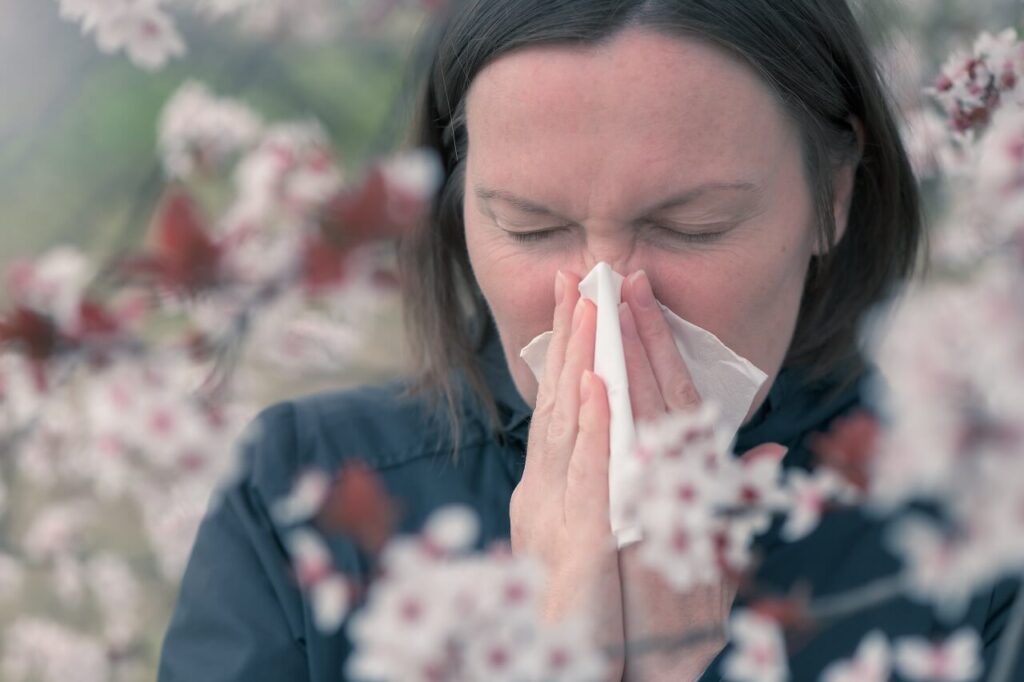Effective Precautions and Treatment for seasonal allergies:
Spring season is often associated with allergies, as many people experience increased symptoms. It is because spring is when many plants bloom and release pollen into the air. Pollen is a common allergen that can cause allergic reactions in some people. If you’re among the millions of people with seasonal allergies, you must be careful and follow the precautions. You may suffer from seasonal allergies like hay fever and allergic rhinitis. But before you settle for plastic-made flowers and fake grass indoors, try some effortless ways to control seasonal allergies. Let’s learn more about dust and pollen allergies in the spring and their treatment.
Spring allergies begin in February and last until early summer in many UAE (United Arab Emirates) regions. Tree pollination starts early in the year, followed by grass and ragweed pollination later in the spring and summer. However, grass may pollinate for most of the year in tropical climates. Plants may begin pollinating earlier in the winter if the temperatures are mild. A wet spring can also encourage rapid plant growth and an increase in mold, prolonging symptoms into the fall.
Spring Allergies:
- Grass Pollen
- Weed Pollen
- Tree
On mainly sunny days, your spring pollen allergies may become more severe because the wind makes it easier for this pollen to travel through the air.
Summer Allergy:
- Fungus Spore
- Mold
- Grass Pollen
Allergies in the Fall and Winter:
- Weed
- Pollen
- Mold Dust
What are seasonal allergies’ signs and symptoms?
If you are allergic to airborne pollen spores, seasonal allergies can manifest at specific times of the year. They are distinct from so-called perennial allergies, which have symptoms that can last throughout the entire year. Because different plants release their pollen at other times, you might only experience symptoms once or twice a year, depending on which kind causes your reaction.
Find out about seasonal allergies, when you are most likely to get them, and how to treat your allergy symptoms so you can enjoy your indoor and outdoor activities. At Call Doctor, we provide the best allergy treatments in your comfort.

Common symptoms of spring allergies include:
Seasonal allergies may be to blame if your family experiences “cold” symptoms simultaneously yearly. The following are examples of allergy symptoms, which typically appear suddenly and persist as long as the individual is exposed to the allergen:
- Sneezing
- Runny or stuffy nose
- Itchy or watery eyes
- Scratchy throat or coughing
- Fatigue
- Headaches
- Ear congestion
- Sore throat, nose, or throat,
- Congestion
- Postnasal drip
- Asthma
- Redness of the skin
- Shortness of breath
When does pollen allergy season begin?
For different people, allergy season can mean other things. In most cases, it depends on when the irritant or pollen that triggers an immune response is present in the air. If you are only allergic to one irritant, allergy season may last only a few weeks or months each year. However, if several different allergens cause your symptoms, you may be affected for two or more seasons. Concisely, depending on your triggers, any season can be “allergy season.”

Reduce your exposure to dust and pollen allergy triggers:
To reduce your exposure to the substances (allergens) that cause allergy symptoms:
- When it’s dry and windy, stay inside. After a good rain, which helps remove pollen from the air, it’s best to go outside.
- Mowing the lawn, pulling weeds, and other gardening tasks that produce allergens should be avoided.
- To remove or eliminate pollen from your hair and skin, shower and remove any clothes you’ve worn outside.
- Hanging clothes outside can cause pollen to stick to towels and sheets.
- If you are doing chores outside, wear a face mask.
- When pollen counts are high, take extra precautions. Seasonal allergy symptoms can worsen when there is a lot of pollen in the air. You can reduce your exposure by taking these measures:
- Take allergy medications before your symptoms start if high pollen counts are expected.
- Keep the doors and windows closed at night and avoid going outside early in the morning or when pollen counts are at their highest.
- Keep the air in your home clean; no magic product can eliminate all allergens, but these tips may help. Moreover, utilize air conditioning in both your home and your vehicle.
- Using a dehumidifier, keep the air inside dry. Furthermore, use a HEPA filter vacuum cleaner to vacuum the floors frequently.

How are seasonal allergies treated?
There are several ways to manage dust and pollen allergies, including:
- Avoiding allergens: Stay indoors when pollen counts are high, and keep windows and doors closed to prevent pollen from entering your home.
- Taking medication: Antihistamines, decongestants, and nasal corticosteroids can help relieve allergy symptoms.
- Using nasal saline: A nasal saline rinse can help clear nasal passages and remove allergens.
- Getting allergy shots: Allergy or immunotherapy helps reduce your sensitivity to allergens over time.
It’s important to talk to our healthcare provider if you are experiencing symptoms of allergies, as they can help determine the best course of treatment for you.
Be safe, be healthy, and be happy:
Many safe and effective allergy medicines can be used by taking precautions to reduce exposure to allergy triggers to target the symptoms you have the most trouble with. Nowadays, oral antihistamines, nose sprays, and eye drops are the most common over-the-counter allergy medications. Allergy sufferers can always count on our doctors for assistance. You can get in touch with us by sending us an email or calling us on 800 200 400.




